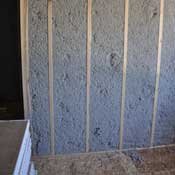Wednesday, November 16, 2011
I think about my retirement often and how great it has the potential of being. Then I panic thinking about whether we'll have enough, about the best strategy for saving and about where our hard-earned money will be the safest. We are running out of space in the backyard with all the mason jars full of nickels we've buried.
But wait: I shouldn't be telling you this.
I recently ran across an article that asked the question: Is it better to invest in energy upgrades or a 401K? This caught my attention.
To summarize the article, as you might be able to guess, energy efficiencies make sense. Energy costs have increased on average 6.33 percent since 1974, while Social Security benefits have only increased on average 1.54 percent based on the consumer price index. On the other hand, let's say you aren't counting on Social Security. Instead, you are banking on a 10 percent return on investment with your 401K. Is this a safe strategy? I think over the long haul it is.
You are savvy, and you have something that you know is increasing 6 percent a year or something that may increase 10 percent a year. Which is the safer bet? What if you could make your home more comfortable while making an energy investment? What if you could make this investment without having to change your lifestyle and without having to walk around in January in a snowsuit to conserve on your heating bill? Doesn't all that make more sense?
So what is the best approach for making an energy investment?
The first rule of an energy retrofit is to work with licensed and respected professionals that understand an energy-efficient retrofit. If you start this process off with the statement, "I know a guy," ask yourself: Is it the right guy? Be prepared and have lots of questions ready for them. Questions to keep in mind are what tests will be performed, what equipment will be used and are references available.
The Green Home Guide has local professionals that can help.
The second thing you will need is an energy audit to know what you are dealing with. This audit should include a test on your ductwork and a test to see where the air in your house is leaking to the outside. Auditors should also look at several years of your power bills to know what you have been spending. A licensed home energy rating system (HERS) professional can perform the tests.
Once you complete an energy audit, you can use the next three steps to move forward with the most economical approach. The first step is to address the basic building fundamentals. How much insulation is installed in my house? How much do my ducts leak? How much do my walls, windows and doors leak? Is my house too humid? What kind of lighting do I have installed? Are my appliances efficient? What is my basic plug load?
Addressing these areas first can save you as much as 20 percent on your utilities, according to energy-auditing professionals. The older your home, the higher the chances are that you don't have enough insulation. Even if you do, it may be installed incorrectly.
Small defects in insulation amount to huge reductions in its efficiency. An error of 5 percent can mean a reduction of almost 50 percent in the insulation's value.
Installing five compact fluorescent bulbs on the five most used lights in your house can save as much as $100 per year. Look for Energy Star appliances when you buy new ones. An Energy Star refrigerator saves $250 a year on average.
The term "plug load" sounds complicated, and it can be, but the simple rule is anything with a box that plugs into the wall will cost you about a $1 a month. (Think hair dryers, cell phone chargers and computer peripherals.) These can add up quickly.
The next step is to look at the major systems in your home, such as heating and air conditioning equipment, and water heating. Don't do this step first because these items are expensive and you want them to be sized correctly for your house. If the air-conditioner repair person walks in and asks how big your house is and then tells you how big the new equipment needs to be without picking up a pencil, please escort them out the door.
Look for a higher seasonal energy efficient ratio number. Thirteen SEER on air conditioners is the minimum standard. Fourteen and higher is much better. If you addressed the first step right, then your home will be tighter to the outside air. You need to make sure it gets fresh air on your terms.
The average family of four wastes 12,000 gallons of hot water a year just waiting for hot water to arrive at the faucet. That amounts to about $270 a year. If you can shorten that time, you will save water and money. You can start by insulating your hot water pipers with a thermal resistant insulation, such as R-4.
The final step is to look at renewable energy sources. This will include solar power, solar water heating and wind and water catchment. You save this step for last because this is the most expensive step. You want to first reduce your energy demand as much as possible, so you don't buy more solar panels than you need. At the moment, if Tennessee Valley Authority provides your power, they will pay you a lot more money than Entergy for the excess power you may produce and shorten the pay-back period of the renewables.
If you make it to through the third step, you may reduce your utility demand by 80 percent or more. While it can be expensive to go that far, if it is done right, it can guarantee you a nice dividend that pays off each month.
